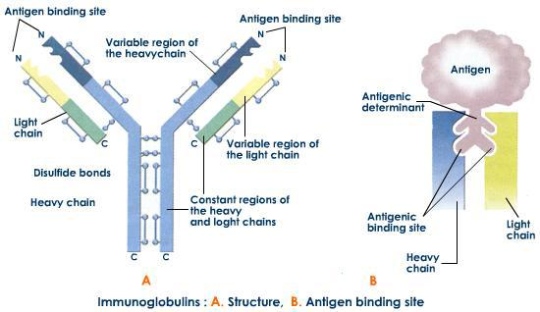8.2.2 ACQUIRED IMMUNITY NEET
8.2.2 Acquired Immunity
- Acquired immunity, on the other hand, is pathogen specific.
- It is characterised by memory (TM-cell).
- Primary response: when our body encounters a pathogen for the first time produces a response called primary response which is of low intensity.
- Secondary response: Subsequent encounter with the same pathogen elicits a highly intensified secondary or anamnestic response.
 |
| various source |
- This is ascribed to the fact that our body appears to have memory of the first encounter.
- The primary and secondary immune responses are carried out with the help of two special types of lymphocytes present in our blood, i.e., B-lymphocytes and T-lymphocytes.
- The B-lymphocytes produce an army of proteins in response to pathogens into our blood to fight with them.
- These proteins are called antibodies.
- The antigenic determinant or epitope is recognized by the paratope of the antibody, situated at the variable region of the polypeptide chain.
- The antigen-binding fragment (Fab) is a region on an antibody that binds to antigens.
- The T-cells themselves do not secrete antibodies but help B cells (Plasma cell or Kart wheel cell) produce them.
Types of T cell
- Killer T cells CD8+ [TK]: when come in contact (bind) with antigen (non-self cell or pathogen) it produces perforin, which puncture the pathogen's cell membrane and kills it. They destroy body cells too before the pathogen multiply in it. It also kills cancer cell.
- Helper T cell [TH]: these cell stimulate the B-cell to produce antibody. they also stimulate the Killer cell to destroy the pathogen or non-self cell.
- Suppressor T cell [TS]: these cells inhibit the immune response of both T and B cell when infection is under control.
- Memory cells [TM]: these cell are ready to mount a rapid and vigorous attack as soon as the same pathogen infect the body again.
- Plasma B cell: these cell are antibody factories.
- Memory B cell: Memory B cells live for very long time and serve to quickly dispose of antigen in case of reinfection of the same virus and bacteria.
Antibodies and its types:
- Each antibody molecule has four peptide chains, two small called light chains and two longer called heavy chains. Hence, an antibody is represented as H2L2.

- There is one disulfide bond between heavy and light chain
- There are two disulfide bond in each light chain
- There are four disulfide bond in each heavy chain
- There are sixteen disulfide bonds in a monomer of antibody molecule.
Reactions:
- Neutralization: antigen-antibody reaction to destroy pathogens using antitoxins such as antitoxins, antivenom, etc.
- Precipitation reaction: It involves the reaction of soluble antigen with soluble antibodies to form large interlocking aggravated called lattice. It occurs in two distinct stages.
- Agglutination reaction: The clumping of cells such as bacteria or red blood cells in the presence of an antibody.
- ComplementActivation: antigen-antibody complex activates complement proteins which may 1. lyse the cell wall of bacterium, causing their disintegration; 2. initiate inflammatory response; 3. opsonise the antigen; or 4. attract phagocyte to the area of infection.
- Opsonization: An opsonin is any molecule that enhances phagocytosis by marking an antigen for an immune response or marking dead cells for recycling.

- Different types of antibodies are produced in our body.
- IgA, IgM, IgE, IgG are some of them.
- Because these antibodies are found in the blood, the response is also called as humoral immune response.
- This is one of the two types of our acquired immune response – antibody mediated.
- The second type is called cell-mediated immune response or cell-mediated immunity (CMI).
- The T-lymphocytes mediate CMI.
- Very often, when some human organs like heart, eye, liver, kidney fail to function satisfactorily, transplatation is the only remedy to enable the patient to live a normal life. Then a search begins – to find a suitable donor.
Why is it that the organs cannot be taken from just anybody? What is it that the doctors check?
- Grafts from just any source – an animal, another primate, or any human beings cannot be made since the grafts would be rejected sooner or later.
- Tissue matching, blood group matching are essential before undertaking any graft/transplant and even after this the patient has to take immuno–suppresants all his/her life.
- The body is able to differentiate ‘self ’ and ‘nonself’ and the cell-mediated immune response is responsible for the graft rejection.


Comments
Post a Comment